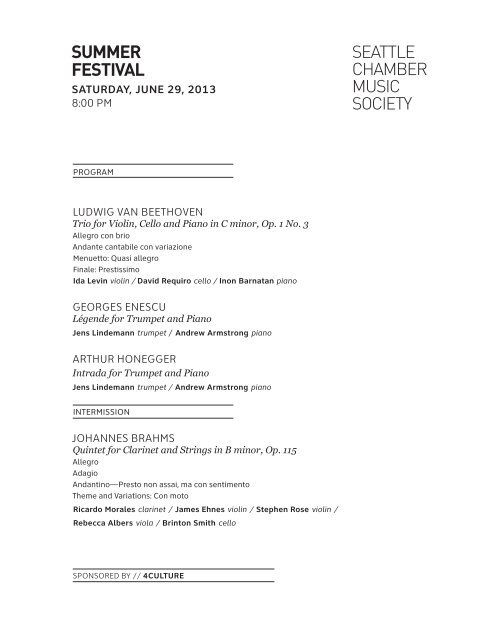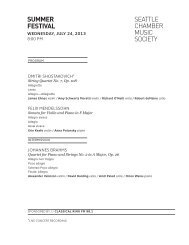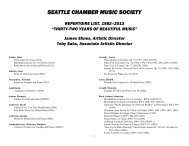View Program Notes - Seattle Chamber Music Society
View Program Notes - Seattle Chamber Music Society
View Program Notes - Seattle Chamber Music Society
You also want an ePaper? Increase the reach of your titles
YUMPU automatically turns print PDFs into web optimized ePapers that Google loves.
saturday, JUne 29, 2013<br />
8:00 pm<br />
program<br />
Ludwig van Beethoven<br />
Trio for Violin, Cello and Piano in C minor, Op. 1 No. 3<br />
Allegro con brio<br />
Andante cantabile con variazione<br />
Menuetto: Quasi allegro<br />
Finale: Prestissimo<br />
Ida Levin violin / David Requiro cello / Inon Barnatan piano<br />
Georges Enescu<br />
Légende for Trumpet and Piano<br />
Jens Lindemann trumpet / Andrew Armstrong piano<br />
Arthur Honegger<br />
Intrada for Trumpet and Piano<br />
Jens Lindemann trumpet / Andrew Armstrong piano<br />
INTERMISSION<br />
Johannes Brahms<br />
Quintet for Clarinet and Strings in B minor, Op. 115<br />
Allegro<br />
Adagio<br />
Andantino—Presto non assai, ma con sentimento<br />
Theme and Variations: Con moto<br />
Ricardo Morales clarinet / James Ehnes violin / Stephen Rose violin /<br />
Rebecca Albers viola / Brinton Smith cello<br />
sponsored by // 4culture
Ludwig van Beethoven<br />
(1770–1827)<br />
Trio for Violin, Cello and Piano in C minor,<br />
Op. 1 No. 3 (1791–92)<br />
When Beethoven journeyed to Vienna in 1792 to study<br />
with Haydn (and subsequently with Albrechtsberger<br />
and the unfairly maligned Salieri), he carried with him a<br />
letter from Count Waldstein, who would be a long-time<br />
patron, and at least one of the Op. 1 trios in anticipation<br />
of lessons with Haydn. “With the help of assiduous labor<br />
you shall receive Mozart’s spirit from Haydn’s hands,”<br />
wrote the Count.<br />
Haydn’s response to the first two Op. 1 trios was<br />
enthusiastic. He appreciated their musical inventiveness<br />
and was fully comfortable with their Classical decorum.<br />
He felt somewhat uneasy about No. 3, however, and<br />
urged Beethoven not to have it published. Cast in C<br />
minor and filled with an insistent power, it seemed<br />
to threaten Classical standards of “good taste.”<br />
Such passionate assertiveness, of course, became<br />
Beethoven’s great calling card. The key itself—C<br />
minor—would serve the composer well as the tonality<br />
through which he would express his strongest feelings,<br />
as in the Pathétique Sonata, third piano concerto and<br />
fifth symphony.<br />
Advance notice on Beethoven’s wonted assertiveness<br />
can be heard with the very opening bars of the first<br />
movement of the C-minor Piano Trio. Like a coiled<br />
spring, the compact and dramatic theme of the<br />
opening Allegro con brio impels the music forcefully,<br />
momentarily offset by a lyrical countersubject. The<br />
development finds the composer toying with the first<br />
theme by transforming it into a charming waltz before<br />
sweeping it aside in favor of a stormy restatement<br />
of this same musical kernel. One can only imagine<br />
how unsettling this was for sophisticated Viennese<br />
audiences in the 1790s. Given the increasing<br />
dissonance and anxiety of music in the past centuryplus,<br />
it is useful to approach Beethoven’s musical<br />
aggressiveness as if hearing such audacious music as if<br />
for the first time—difficult, perhaps, but worth the effort.<br />
As a breather, Beethoven moves into the relative major<br />
(E-flat) in the Andante cantabile con variazione, its five<br />
increasingly complex and emotionally rich variations<br />
evolving from a deceptively simple tune. Here the<br />
composer pays homage to the spirit of Haydn and<br />
Mozart.<br />
One might expect the third movement to move<br />
forcefully into the future, i.e., a burly Scherzo, but in<br />
fact Beethoven retreats here into the grace of an 18thcentury<br />
Menuetto—or does he? Beneath the gentle<br />
rhythm lurks a sense of menace that subtly reflects the<br />
anti-aristocratic fervor that coursed through Europe in<br />
the wake of the French Revolution.<br />
What was merely implicit in the Menuetto is forcefully<br />
catapulted in the brusquely energetic Finale, whose<br />
“Mannheim rocket” theme launches upward between<br />
emphatic repeated chords—another harbinger of<br />
things to come. Yet abruptly the tempest is halted, and<br />
Beethoven beguiles our ears with a lovely counter<br />
theme marked dolce. The rest of the movement<br />
explores increasingly fervent emotional expression<br />
before coming to an unexpectedly quiet ending. Such<br />
dislocations and surprises would become Beethoven’s<br />
stock-in-trade as he expanded the range of his<br />
exploratory forays.<br />
Georges Enescu<br />
(1881–1955)<br />
Légende for Trumpet and Piano (1906)<br />
Enescu (often spelled Enesco, in accordance with<br />
French usage) was a superb violinist (teacher of<br />
Yehudi Menuhin and several other fine violinists),<br />
excellent pianist, and a fine composer whose works are<br />
shamefully under-represented in concert—other than<br />
the ubiquitous and engaging Rumanian Rhapsodies, of<br />
course. His ample talent expressed itself early, and led<br />
to fruitful years of study with, among others, Massenet<br />
and Fauré in Paris. His first published work, Poème<br />
roumain, premiered in 1898 and put Rumania on the<br />
map, musically speaking.<br />
Enescu composed his brief single-movement Légende<br />
for Trumpet and Piano in homage to Merri Franquin, who<br />
served as professor of cornet at the Paris Conservatoire.<br />
Less than much of the composer’s later music, which<br />
summer festival //
drew from Hungarian and gypsy tradition, the accent<br />
here is more akin to the French impressionism of<br />
Massenet and Fauré.<br />
The piece opens with a quiet and mildly dissonant<br />
introduction on the piano before the trumpet presents<br />
a low-lying lyrical theme of modest dynamics—in<br />
contrast to the traditional assertive/martial fashion<br />
often employed in primary thematic material for<br />
trumpet works. As the movement progresses the music<br />
does, in fact, become increasingly animated in a series<br />
of brief episodes incorporating rapid chromatic scalebased<br />
figurations, triple tonguing and wide leaps, all<br />
testifying to Enescu’s intent in expanding the soloistic<br />
possibilities of the trumpet. Adding further to the<br />
timbral appeal of the piece the closing section employs<br />
a mute when reprising the trumpet’s opening theme.<br />
Arthur HoneggeR<br />
(1892–1955)<br />
Intrada for Trumpet and Piano (1947)<br />
Born in Le Havre to Swiss parents Arthur Honegger lived<br />
most of his life in France, trapped, as it were, in Paris<br />
during World War II where he allied himself with the<br />
French Resistance against the Nazi invaders. Because of<br />
his reputation Honegger was largely left undisturbed by<br />
the Pétain government.<br />
Two decades before the War, two articles appeared in 1920<br />
by music critic Henri Collet (inspired and probably led by<br />
Jean Cocteau). Collet selected a group he termed “Les Six,”<br />
a distinctly French collective that attempted to supplant<br />
Debussyan impressionism by a newer, vital resurgence of<br />
French musical composition. A member of “Les Six” (the<br />
other five were Georges Auric, Louis Durey, Darius Milhaud,<br />
Francis Poulenc, and Germaine Tailleferre), Honegger’s<br />
stylistic preferences were clearly Germanic, especially<br />
in his focus on structure. He once noted “I attach great<br />
importance to musical architecture, which I should never<br />
want to see sacrificed for reasons of literary or pictorial<br />
order. My model is Bach…. I do not seek, as do certain anti-<br />
Impressionists, the return to harmonic simplicity. I find, on<br />
the contrary, that we should use the harmonic materials<br />
created by the school which preceded us, but in a different<br />
way—as the base of lines and rhythms.”<br />
Two years after the end of the War Honegger composed<br />
the Intrada for Trumpet and Piano specifically for<br />
end-of-term examinations for student trumpet players<br />
that tested sight-reading and technique. The Intrada<br />
also served as a test piece for the Geneva International<br />
Competition. Though not intended as an addition to the<br />
repertoire the work greatly expanded its initial purpose<br />
and has enjoyed frequent performance by trumpet<br />
players.<br />
Reflecting Honegger’s predilection for formal<br />
development he carefully laid out the Intrada as a<br />
three-part essay. The opening Maestoso section, tersely<br />
introduced by a single chord on the piano, presents a<br />
rising arpeggio theme that bounds up and then down<br />
through the trumpet’s range. This part alone is replete<br />
with brilliant flourishes often high in the instrument’s<br />
tessitura. Listeners may hear a familial resemblance to<br />
rhythmic figures that recall Bach—Honegger’s ideal.<br />
An insistent Allegro follows, energized by punching/<br />
galloping rhythms from the piano as the trumpet sails<br />
aloft in a veritable soaring dance. The closing section<br />
reprises the opening material and draws to a short but<br />
stately close.<br />
Johannes Brahms<br />
(1833–1897)<br />
Quintet for Clarinet and Strings in B minor,<br />
Op. 115 (1891)<br />
In 1891, Brahms paid a visit—his second—to Meiningen,<br />
where their famous orchestra had premiered Brahms’<br />
Fourth Symphony in 1885. On this occasion he met the<br />
Meiningen Orchestra’s principal clarinetist, Richard<br />
Muhlfeld. The composer noted Muhlfeld’s polish and<br />
what the composer termed his “feminine sensitivity,”<br />
even going so far as to refer to the musician as “my<br />
prima donna.”<br />
The meeting proved to be fateful: Brahms rescinded a threat to<br />
his publisher to stop composing, penning four superb chamber<br />
works featuring clarinet: the knotty and ascetic Clarinet Trio,<br />
Op. 114; two mellifluous Sonatas for Clarinet and Piano, Op.<br />
120 (also available in a viola/piano version and an infrequently<br />
performed violin/piano arrangement as well); and the sublime<br />
Quintet for Clarinet and Strings, Op. 115.<br />
june 29, 2013 // program notes
The Quintet is a masterly essay noted for its subtlety<br />
and unified thematic structure. All of its many attractive<br />
tunes derive from material presented in the very first<br />
three bars of the opening movement. The gently<br />
undulating 16ths of the first two measures and the<br />
more sustained dipping phrase of the third launch<br />
at least three distinct but related thematic networks<br />
that combine to influence the entire work. A typically<br />
Brahmsian device is heard at the outset, where<br />
melodically and harmonically the opening of the theme<br />
lies simultaneously in both D major and B minor, an<br />
intentional ambiguity that one finds in much earlier<br />
works such as the G-Major Sextet and even the roiling<br />
opening of the D-minor Piano Concerto.<br />
The phrase “autumnal nostalgia” is often used to<br />
characterize late Brahms, and though it is sometimes<br />
off the mark, it readily applies to the Quintet, though<br />
there are undeniable stretches of joy and rapture.<br />
Brahms puts the clarinet’s tonally varied tessitura to<br />
imaginative use in giving voice to the instrument’s clear<br />
high soprano and clarino register, the hollow, breathy<br />
mastery of its middle tones, and the dark, romantic cast<br />
of its low chalumeau range.<br />
The opening Allegro fills a broad and spacious sonata<br />
structure initiated by a beguiling theme in the violins.<br />
Brahms called this kind of motif “unscheinbarket,”<br />
unobtrusive. It insinuates itself into the listener’s<br />
consciousness with it tender beauty, rather than<br />
dazzling him or her. Excitement builds as the music<br />
unfolds, leading to a transition built around forceful,<br />
staccato notes. This section leads to the second theme,<br />
voiced by the clarinet, which is directly derived from<br />
the opening theme’s rapid-note figure. The two themes<br />
provide the raw material for the entire movement.<br />
In the Adagio, Brahms mutes the strings to create an<br />
aura of hushed beauty. The basic theme is akin to a<br />
serene and dreamlike love song. The viola is entrusted<br />
with a countermelody recalling the first movement.<br />
The clarinet is given free rein in the center of this<br />
otherwise rapt movement; the prevailing ruminative<br />
beauty is dramatically interrupted by wildly evocative<br />
clarinet flourishes à la gypsy music. Brahms was always<br />
fond of Hungarian music, and in this section gives the<br />
strings a cimbalom-like accompaniment reflecting that<br />
traditional folk instrument’s plucked zither-like sound.<br />
An Andantino, rather than a Scherzo follows, though at<br />
bar 34 the tempo and élan pick up in response to the<br />
Presto marking in the score. This is a gently soothing<br />
movement that leavens the underlying melancholy<br />
of the work. As in the first movement, tonality shifts<br />
between D major and B minor, and the main theme is<br />
built from fragments from the work’s opening tune.<br />
Brahms, ever the master of variation, ends the Quintet<br />
with a set of five variations. Each variation explores a<br />
different aspect of the theme (itself a composite drawn<br />
from the previously used melodic fragments). By the<br />
time he arrives at the final variation, he has come full<br />
circle to yet another version of the first movement’s<br />
main theme. In the coda Brahms reinforces the point by<br />
presenting an almost verbatim reprise of the theme as it<br />
appears in the first movement.<br />
<strong>Program</strong> <strong>Notes</strong> by Steven Lowe<br />
summer festival //







